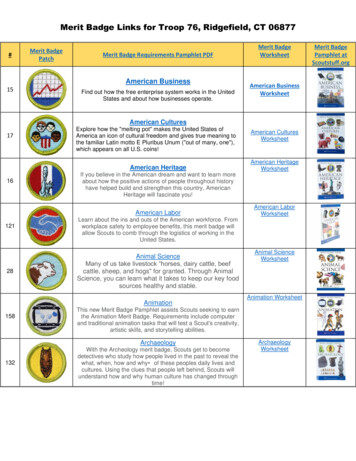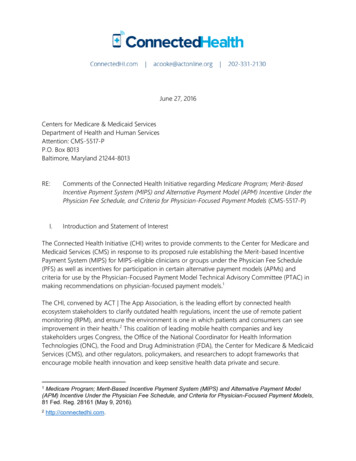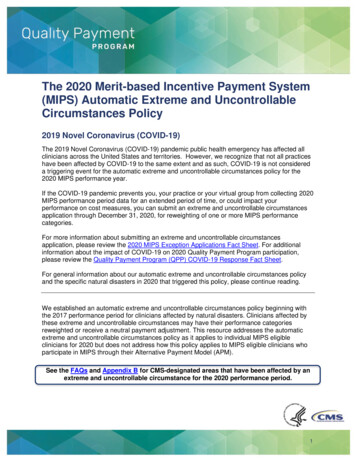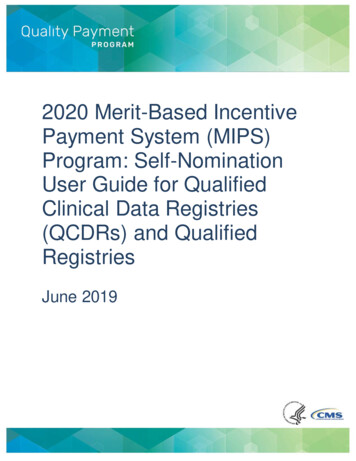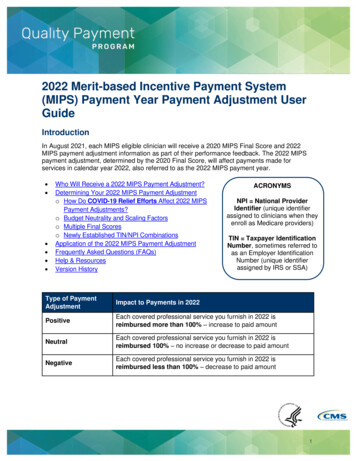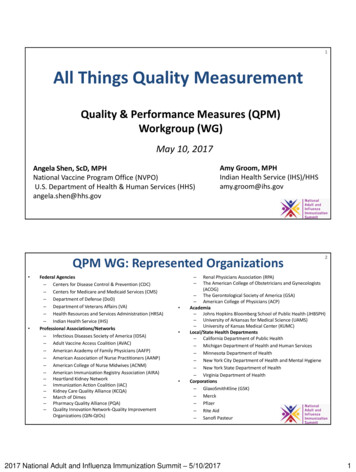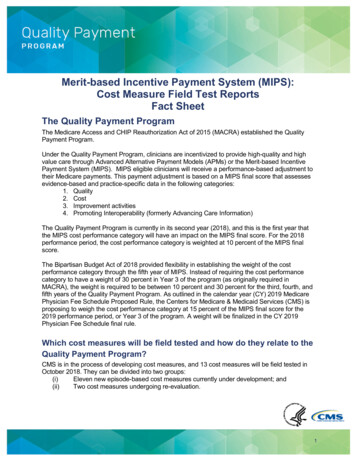
Transcription
Merit-based Incentive Payment System (MIPS):Cost Measure Field Test ReportsFact SheetThe Quality Payment ProgramThe Medicare Access and CHIP Reauthorization Act of 2015 (MACRA) established the QualityPayment Program.Under the Quality Payment Program, clinicians are incentivized to provide high-quality and highvalue care through Advanced Alternative Payment Models (APMs) or the Merit-based IncentivePayment System (MIPS). MIPS eligible clinicians will receive a performance-based adjustment totheir Medicare payments. This payment adjustment is based on a MIPS final score that assessesevidence-based and practice-specific data in the following categories:1. Quality2. Cost3. Improvement activities4. Promoting Interoperability (formerly Advancing Care Information)The Quality Payment Program is currently in its second year (2018), and this is the first year thatthe MIPS cost performance category will have an impact on the MIPS final score. For the 2018performance period, the cost performance category is weighted at 10 percent of the MIPS finalscore.The Bipartisan Budget Act of 2018 provided flexibility in establishing the weight of the costperformance category through the fifth year of MIPS. Instead of requiring the cost performancecategory to have a weight of 30 percent in Year 3 of the program (as originally required inMACRA), the weight is required to be between 10 percent and 30 percent for the third, fourth, andfifth years of the Quality Payment Program. As outlined in the calendar year (CY) 2019 MedicarePhysician Fee Schedule Proposed Rule, the Centers for Medicare & Medicaid Services (CMS) isproposing to weigh the cost performance category at 15 percent of the MIPS final score for the2019 performance period, or Year 3 of the program. A weight will be finalized in the CY 2019Physician Fee Schedule final rule.Which cost measures will be field tested and how do they relate to theQuality Payment Program?CMS is in the process of developing cost measures, and 13 cost measures will be field tested inOctober 2018. They can be divided into two groups:(i)Eleven new episode-based cost measures currently under development; and(ii)Two cost measures undergoing re-evaluation.1
CMS worked with measure development contractor Acumen, LLC (referred to as “Acumen”) todevelop these cost measures. Under MACRA, MIPS involves the use of a methodology foranalyzing cost, as appropriate, which includes consideration of patient condition groups and careepisode groups (referred to as “episode groups”). As a result, 11 episode-based cost measuresare currently under development and will be field tested before consideration of their potential usein MIPS.The measure developer is developing these 11 measures with extensive input from 10 ClinicalSubcommittees and 11 measure-specific workgroups, a technical expert panel (TEP), Person andFamily Committee, and the public: Acute Kidney Injury Requiring New Inpatient Dialysis Elective Primary Hip Arthroplasty Femoral or Inguinal Hernia Repair Hemodialysis Access Creation Inpatient Chronic Obstructive Pulmonary Disease (COPD) Exacerbation Lower Gastrointestinal Hemorrhage Lumbar Spine Fusion for Degenerative Disease, 1-3 Levels Lumpectomy, Partial Mastectomy, Simple Mastectomy Non-Emergent Coronary Artery Bypass Graft (CABG) Psychoses/Related Conditions Renal or Ureteral Stone Surgical TreatmentThe second set of measures that will be field tested include two cost measures undergoing reevaluation, with input from a TEP, an expert workgroup, and public comment: Medicare Spending Per Beneficiary (MSPB) clinician 1 Total Per Capita Cost (TPCC) 21 The re-evaluated MSPB clinician measure that is being field tested in October 2018 is separate from thereporting of the MIPS MSPB measure for the 2017 and 2018 MIPS performance periods. For clarity, wedifferentiate the MSPB measure currently in use in MIPS from the MSPB measure currently undergoingre-evaluation by name. “MSPB” alone refers to the measure currently in use and “MSPB clinician” refersto the measure currently undergoing re-evaluation.2 The re-evaluated TPCC measure that is being field tested in October 2018 is separate from thereporting of the existing TPCC measure for the 2017 and 2018 MIPS performance periods. The existingTPCC measure is sometimes referred to as “Total Per Capita Cost for All Attributed Beneficiaries.” Forclarity in this document, we differentiate the TPCC measure currently in use in MIPS by referring to it asthe “existing” or “current” MIPS TPCC measure.2
The MSPB clinician and TPCC measures are based on measures that have previously beenincluded in the Quality and Resource Use Reports (QRURs) provided to clinicians and measuresthat are currently used in the cost performance category of MIPS. The existing MIPS measurescurrently in use will be used to calculate the Year 2 cost performance category score and willimpact the payment adjustment for MIPS eligible clinicians. The existing MIPS versions of thesemeasures that are currently in use are separate from the two cost measures that are undergoingre-evaluation and that will be field tested this year, before consideration of their potential use infuture years of MIPS.Do the cost measures being field tested affect my 2018 or 2019 MIPSscore?No. The cost measures being field tested in October 2018 are not part of the MIPS costperformance category, and so do not count towards your MIPS final score. As such, the fieldtesting cost measures do not affect any payment adjustments.When will these cost measures be used in MIPS?Possibly in the 2020 MIPS performance period or beyond. The 11 episode-based measures andthe MSPB clinician and TPCC measures undergoing re-evaluation that will be field testedare not included in the 2018 or 2019 MIPS performance periods. These measures will be fieldtested before consideration of their potential use in the MIPS cost performance category in afuture year. As part of this field testing, CMS and Acumen will seek stakeholder feedback on thedraft measure specifications for the cost measures in their current stage of development, the fieldtest report templates, and all accompanying supplemental documentation. This feedback will beconsidered in refining the measures and for future measure development activities.CMS will consider stakeholder feedback, public comments, measure refinements, and MeasureApplications Partnership recommendations before considering the potential use of these 11episode-based cost measures and the cost measures undergoing re-evaluation in the MIPS costperformance category for a future year. This would involve proposing the measures for use inMIPS as part of the notice-and-comment rulemaking process.Why are these cost measures being field tested now?Through field testing, CMS and Acumen will seek voluntary feedback on the episode-based costmeasures, the cost measures undergoing re-evaluation, and their measure reporting format. CMSwill use this feedback to help decide whether these measures should be considered for potentialuse in the MIPS cost performance category, and how the measures and reporting format can beimproved to provide clinicians with actionable information to ensure high quality and high valuecare. Field testing will also serve as an opportunity for clinicians to learn about and gainexperience with these cost measures before they are considered for use in MIPS.Specifically, we will seek feedback on the following types of questions:3
Does the information presented on the measure in the field test report and accompanyingdocumentation help you identify actionable improvements to patient care and to costefficiency?Are the measure specifications for the eleven episode-based cost measures clinicallyvalid? Measure specifications include episode triggers, attribution, assigned services,episode windows, and risk adjustment.Do the measure specifications of the re-evaluated MSPB clinician and TPCC measuresrepresent refinements that are responsive to stakeholder feedback on the existing MIPSversion of the measures? In particular, the key measure specifications of relevance hereare the attribution methods for both measures and service assignment for the MSPBclinician measure.How can we present the information in such a way that it is most useful for meaningfulimprovement?How understandable is the measure documentation provided and how can it be improved?Would additional documents or information be useful for clinicians and other stakeholderstrying to understand these measures?4
Field TestingWhat is field testing?Field testing is a voluntary opportunity for clinicians and other stakeholders to provide feedback onthe draft measure specifications for the cost measures, the field test report format, and thesupplemental documentation. We will be field testing the 13 measures in their current stage ofdevelopment and re-evaluation to seek clinician and other stakeholder feedback by: Posting clinician field test reports for group practices and solo practitioners who meet theminimum number of cases 3 for each measure on the CMS Enterprise Portal. Posting mock reports, draft measure specifications, and supplemental documentation onthe MACRA Feedback page.4When is field testing taking place?Field testing will last from October 3 until October 31, 2018. During this period, stakeholders maysubmit feedback on the measures, report templates, and other documentation.Clinicians Receiving Field Test Report(s)Field Test Reports will be available at the clinician group practice and solo practitioner (or clinician)level. Clinicians are identified by a unique Taxpayer Identification Number (TIN) and NationalProvider Identifier (NPI) combination (TIN-NPI), while clinician groups are identified by their TIN.For clinician group practices, the group practice must meet the minimum number of cases for themeasure across all clinicians billing under the group practice TIN. For solo practitioners, the clinicianmust meet the minimum number of cases by him or herself.Three types of field test reports will be provided to group practices and solo practitioners as shownin Table 1 below.A case can be an episode or a beneficiary depending on the measure.CMS, “Cost Measure Field Testing”, MACRA Feedback Page, MACRA-MIPS-and-APMs/MACRAMIPS-and-APMs.html.345
No dataField Test ReportWhat types ofclinicians arelikely to receive aField TestReport?How many casesdoes a clinicianor clinician groupneed to receive afield test report?What is themeasurementperiod?What is theformat of thereport?Table 1. Types of Field Test ReportsNewly DevelopedMeasuresEpisode-Based CostMeasuresClinicians who perform theprocedures (for proceduralepisode groups) ormanage hospitalizations(for acute inpatient medicalcondition episode groups)for the 11 newly developedepisode-based costmeasuresMeasures Undergoing Re-evaluationMSPB clinicianTPCCClinicians who are part of aTIN that admits patients tothe hospital, and who for: Medical MedicareSeverity DiagnosisRelated Groups (MSDRGs), demonstratesmanagement of apatient’s condition bymeeting or exceeding aparticular threshold ofevaluation andmanagement (E&M)claims billed Surgical MS-DRGs,bills the core procedureof the stayClinicians who deliverprimary care servicesto patients with apattern indicative of aprimary carerelationship with apatient10 episodes for at leastone of the 11 episodebased cost measures35 episodes20 beneficiariesJanuary 1, 2017 toDecember 31, 2017January 1, 2017 toDecember 31, 2017October 1, 2016 toSeptember 30, 2017 5One Excel file. If you meetthe case minimum for morethan one of the 11 episodebased cost measures,each measure will be on aseparate tab in one report.One PDF and one CSV fileOne PDF and oneCSV fileThe attributable months between October 1, 2016 and September 30, 2017, inclusive, are included inthe calculation of the TPCC measure. The year-long measurement period is broken up into 13 four-weekmonths.56
Providing Feedback to Field Test ReportsAll stakeholders can provide feedback on the measures, documentation, and report presentationthrough this online survey during field testing.6 Field testing will take place from October 3, 2018through October 31, 2018. Stakeholders can attach a PDF or Word document with theircomments. Comments may be submitted anonymously if preferred.Episode-Based Cost MeasuresWhat are episode-based cost measures?Episode-based cost measures represent the cost to Medicare for the items and servicesfurnished to a patient during an episode of care (“episode”). Episode-based cost measuresinform clinicians about the cost of the care they are responsible for providing to a beneficiaryduring the episode’s timeframe. In the field test reports and their supplemental documentation,the term “cost” generally means the Medicare allowed amount, which includes both Medicaretrust fund payments and any applicable beneficiary deductible and coinsurance amounts, ontraditional, fee-for-service claims.Episode-based cost measures are calculated with Medicare Parts A and B fee-for-serviceclaims data and are based on episode groups. Episode groups: Represent a clinically cohesive set of medical services rendered to treat a given medicalcondition. Aggregate all items and services provided for a defined patient cohort to assess the totalcost of care. Are defined around treatment for a condition (i.e., acute inpatient or chronic) orperformance of a procedure.Services in the episode group could be treatment services, diagnostic services, and ancillaryitems and services directly related to treatment (such as anesthesia for a surgical procedure).They can also be services that happen after the initial treatment period that may be given topatients as follow-up care or to treat complications resulting from the treatment.An episode is a specific instance of an episode group for a given patient and clinician. Forexample, in a given year, a clinician might be attributed 20 episodes (instances of the episodegroup) from the episode group for heart failure.To make sure there is a more accurate comparison of cost across clinicians, episode costs arepayment standardized and risk-adjusted. Payment standardization adjusts the allowed amount for a Medicare service to facilitatecost comparisons and limit observed differences in costs to those that may result fromhealth care delivery choices. Payment standardized costs remove the effect of differencesin Medicare payment among health care providers that are the result of differences inThe field testing online survey will be open beginning the first week of October 2018 at this t-measures-field-testing.67
regional health care provider expenses measured by hospital wage indexes andgeographic price cost indexes (GPCIs) or other payment adjustments such as those forteaching hospitals.Risk adjustment accounts for patient characteristics that can influence spending and areoutside of clinician control. For example, for the Renal or Ureteral Stone SurgicalTreatment episode-based cost measure, the risk adjustment model may account forpatients with a history of end stage renal disease (ESRD).Attribution of Episodes to a Clinician for Episode-Based Cost MeasureAfter episodes begin, or are triggered, clinicians are identified using the TIN field, along with NPIinformation in the “rendering provider” field on Part B Physician/Supplier (PB) claims. Themethod of attribution varies by episode type: For procedural episode groups, episodes are attributed to the clinician(s) or cliniciangroup(s) rendering the trigger services as identified by Current ProceduralTerminology/Healthcare Common Procedure Coding System (CPT/HCPCS) procedurecodes.o For example, an orthopedic surgeon billing CPT/HCPCS code 27130 would beattributed an Elective Primary Hip Arthroplasty episode. Additional conditions totrigger an episode may apply, for instance if occurring concurrent to an inpatienthospitalization. For acute inpatient medical condition episode groups, an episode is attributed to a cliniciangroup rendering at least 30 percent of inpatient E&M services during an inpatienthospitalization with an MS-DRG for the episode group, and to clinicians who bill at leastone inpatient E&M claim line under a TIN that meets the 30 percent threshold.o For example, for an internist to be attributed an episode for the Inpatient COPDExacerbation measure: The internist must bill at least one inpatient E&M PB claim line during thetrigger inpatient hospitalization. The PB claim line must be concurrent to an inpatient hospitalization withMS-DRG 190 and must be accompanied by a relevant diagnosis asspecified by the Clinical Subcommittee. The internist must be part of a TIN that bills 30 percent of inpatient E&Mcodes on PB claim lines for that inpatient hospitalization.Calculation of Episode-Based Cost MeasuresTo calculate the measures, we perform the following steps using all episodes in an episodegroup that are attributed to a clinician or clinician group:Step 1: Determine observed costs for each episode by aggregating standardized allowedamounts for services determined to be clinically related to a given condition or procedure thatoccur within the episode window.Step 2: Determine expected costs for each episode through risk adjustment by taking intoaccount factors that are included in the CMS Hierarchical Condition Category Version 22 (CMS-8
HCC V22) 2016 Risk Adjustment Model as well as additional risk adjustors recommended byClinical Subcommittee workgroups for each episode group. If a measure has sub-groups, thisincludes only episodes within the same sub-group nationally.Step 3: Divide the observed cost for each episode by the expected cost to obtain theobserved/expected ratio for each episode.Step 4: Sum the observed/expected ratios for all the episodes across the entire episode group(i.e., across all sub-groups) for the TIN or TIN-NPI.Step 5: Divide by the total number of episodes attributed to the TIN or TIN-NPI across the episodegroup to obtain the average observed/expected ratio for all episodes. This average ratio’s standing relative to 1 is what indicates whether a clinician’s episodescost more or less than expected on average.Step 6: Multiply the result by the national average observed episode cost for all episodes acrossall sub-groups to obtain the cost measure score. This is done to convert the average ratio into a figure that is more meaningful from a costperspective by having the clinician’s average cost measure score represented as a dollaramount rather than a ratio.Re-evaluated Measures1. Medicare Spending Per Beneficiary (MSPB) Clinician MeasureWhat is the MSPB clinician measure?The re-evaluated MSPB clinician measure assesses the cost performance of clinicians whofurnish inpatient care services to Medicare beneficiaries. The measure includes Medicare Parts Aand B costs occurring during the episode window, excluding certain services identified as unlikelyto be influenced by the clinician’s care decisions. As background, the current MSPB measure hasbeen part of the MIPS cost performance category since the 2017 MIPS performance period. Priorto its current use in MIPS, CMS used a version of the MSPB measure in the Value ModifierProgram and reported it in annual QRURs until MACRA ended the Value Modifier program. Themeasure that has been used in MIPS since the 2017 performance period assesses total MedicareParts A and B costs incurred by a single beneficiary immediately prior to, during, and 30 daysfollowing a qualifying inpatient hospital stay and compares these observed costs to expectedcosts.As part of measure maintenance and re-evaluation, the MSPB clinician measure has been refinedthrough stakeholder input and is now being field tested. The MSPB clinician measure has beenre-evaluated with substantial stakeholder feedback and represents a refinement of the MSPBmeasure that is in use for MIPS. This re-evaluated measure will be field tested in October 2018and will not affect payment adjustments. It is separate from the reporting of the MIPS MSPBmeasure for the 2017 and 2018 MIPS performance periods.9
Attribution of Episodes to a Clinician for the Re-evaluated MSPB ClinicianMeasureThe re-evaluated measure uses separate attribution methods for medical and surgical episodes toidentify the clinician(s) responsible for providing these different types of care. Medical episodesare attributed to a clinician group that rendered at least 30 percent of E&M services during theperiod between the index admission date and the discharge date for a hospitalization with amedical MS-DRG, and to any clinician that billed at least one E&M service under a cliniciangroup that meets the 30 percent threshold. Surgical episodes are attributed to the clinician andclinician group that rendered the main procedure of the stay as identified by the CPT/HCPCScode found on the PB claim concurrent to the surgical MS-DRG. The current MSPB measureattributes each episode to the clinician billing the plurality of costs for Medicare PB servicesrendered during an index admission.Calculation of the Re-evaluated MSPB Clinician MeasureThe re-evaluated MSPB clinician measure is calculated through the steps below:Step 1: Determine the observed costs for each episode by aggregating Medicare Parts A andPart B standardized allowed amounts for services that occur within the episode window, excludingcertain services identified as unrelated to the reason for the index inpatient stay.Step 2: Determine expected costs for each episode using a risk adjustment model based on theCMS-HCC V22 2016 Risk Adjustment model with additional modifications specific to the reevaluated MSPB clinician measure as described above.Step 3: Sum the ratio of payment-standardized observed cost (from Step 1) to expected cost(from Step 2) for all the MSPB episodes that are attributed to the TIN.Step 4: Multiply the sum of ratios by the national average payment-standardized observedepisode cost.Step 5: Divide the result of Step 4 by the total number of MSPB episodes attributed to a givenTIN.Steps 3 through 5 together calculate an average ratio of observed to expected costs acrossepisodes and multiply this ratio by a national average observed episode cost. This is done toconvert the final figure (the cost measure score) into a figure that is more meaningful from a costperspective.Although steps 3 through 5 refer to measure calculation for the attributed TIN, analogous stepsapply for calculation of the TIN-NPI level cost measure score.2. Total Per Capita Cost (TPCC) Measure10
What is the TPCC measure?The re-evaluated TPCC measure assesses the cost performance of clinicians providing primarycare management of Medicare beneficiaries. As background, the current TPCC measure has beenpart of the MIPS cost performance category since the 2017 MIPS performance period. Prior to itsuse in MIPS, CMS used a version of the TPCC measure in the Value Modifier Program and reportedit in annual QRURs until MACRA ended the Value Modifier program. The measure currently usedin MIPS is a payment-standardized, risk-adjusted, and specialty-adjusted cost measure focused onclinicians/clinician groups performing primary care services. Specifically, the measure is an averageof per capita costs across all attributed beneficiaries, and includes all Medicare Parts A and B costsacross all attributed beneficiaries.As part of measure maintenance and re-evaluation, the TPCC measure has been refined throughsubstantial stakeholder feedback and is now being field tested. The TPCC measure has been reevaluated with substantial stakeholder feedback and represents a refinement of the TPCC measurethat is in use for MIPS. This re-evaluated measure will be field tested in October 2018 and will notaffect payment adjustments. It is separate from the reporting of the MIPS TPCC measure for the2017 and 2018 MIPS performance periods.Attribution of Episodes to a Clinician for the Re-evaluated TPCC MeasureThe re-evaluated measure only attributes events (defined as primary care E&M services) thatmeet specified criteria. For example, the event will only be considered for attribution if it isaccompanied by another E&M or primary care service. Under the revised measure, eachattributable event initiates a one-year risk window during which a beneficiary’s costs may beattributable to a clinician. The portion of a beneficiary’s costs billed within months (i.e.,episodes) 7 that overlap both the measurement period and an open risk window with a clinicianare attributed to that clinician. In cases where a beneficiary has multiple overlapping episodesassociated with different clinicians in a single month, the beneficiary’s costs for that month areattributed to each clinician associated with an episode that overlaps that month. However, abeneficiary’s costs are only assigned to one clinician within a given clinician group, based onwhich clinician provided the most qualifying primary care events, or in the case of a tie, theclinician that provided the earliest qualifying primary care event.Calculation of the Re-evaluated TPCC MeasureThe TPCC measure is calculated through the steps below:Step 1: Determine observed costs for each episode in the measurement period by aggregatingPart A and Part B standardized allowed amounts for services that occur within the episode.Step 2: Determine risk-adjusted costs for each episode in the measurement period by dividingthe observed costs by the normalized CMS-HCC risk score described above. For episodes withFor the re-evaluated TPCC measure, an episode is a 4-week interval or partial interval associated with abeneficiary during the measurement period that is attributable to a clinician or clinician group based onoverlap with a risk window.711
partial coverage, risk-adjusted costs are pro-rated according to the portion of the period duringwhich the TIN or TIN-NPI was attributed to the beneficiary.Step 3: Trim outliers by assigning the 99th percentile of monthly costs to all episodes in themeasurement period with costs at or above the 99th percentile of costs.Step 4: Normalize risk-adjusted, trimmed costs by applying an adjustment factor to account fordifferences in expected monthly costs related to the number of clinician groups a beneficiarysees in a given month. 8Step 5: Sum normalized, risk-adjusted monthly costs for all episodes attributed to the TIN or TINNPI.Step 6: Divide by the total number of episodes attributed to the TIN or TIN-NPI to obtain theaverage risk-adjusted, normalized cost for all episodes.Measure calculation for a TIN or TIN-NPI is completed with the calculation of Step 6 above. Themeasure constructed via the above steps can be conceptualized as the sum of risk-adjustedtotal monthly costs across all attributed episodes for a TIN or TIN-NPI, divided by the number ofattributed episodes for the TIN or TIN-NPI.Questions or Need More Information?Should you have further questions, please contact the Quality Payment Program Service Centervia telephone at 1-866-288-8292 or via email at qpp@cms.hhs.gov. The Help Desk is availableMonday – Friday; 8:00 A.M. – 8:00 P.M. Eastern Time Zone.8 Specifically, monthly costs are divided by the cube root of the number of clinician groups to which abeneficiary is attributed for a month.12
Which cost measures will be field tested and how do they relate to the Quality Payment Program? CMS is in the process of developing cost measures, and 13 cost measures will be field tested in October 2018. They can be divided into two groups: (i) Eleven new episode-based cost measures currently under development; and
